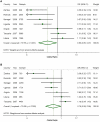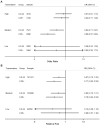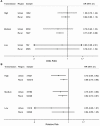Net benefits: a multicountry analysis of observational data examining associations between insecticide-treated mosquito nets and health outcomes
- PMID: 21909249
- PMCID: PMC3167799
- DOI: 10.1371/journal.pmed.1001091
Net benefits: a multicountry analysis of observational data examining associations between insecticide-treated mosquito nets and health outcomes
Abstract
Background: Several sub-Saharan African countries have rapidly scaled up the number of households that own insecticide-treated mosquito nets (ITNs). Although the efficacy of ITNs in trials has been shown, evidence on their impact under routine conditions is limited to a few countries and the extent to which the scale-up of ITNs has improved population health remains uncertain.
Methods and findings: We used matched logistic regression to assess the individual-level association between household ITN ownership or use in children under 5 years of age and the prevalence of parasitemia among children using six malaria indicator surveys (MIS) and one demographic and health survey. We used Cox proportional hazards models to assess the relationship between ITN household ownership and child mortality using 29 demographic and health surveys. The pooled relative reduction in parasitemia prevalence from random effects meta-analysis associated with household ownership of at least one ITN was 20% (95% confidence interval [CI] 3%-35%; I² = 73.5%, p<0.01 for I² value). Sleeping under an ITN was associated with a pooled relative reduction in parasitemia prevalence in children of 24% (95% CI 1%-42%; I² = 79.5%, p<0.001 for I² value). Ownership of at least one ITN was associated with a pooled relative reduction in mortality between 1 month and 5 years of age of 23% (95% CI 13-31%; I² = 25.6%, p>0.05 for I² value).
Conclusions: Our findings across a number of sub-Saharan African countries were highly consistent with results from previous clinical trials. These findings suggest that the recent scale-up in ITN coverage has likely been accompanied by significant reductions in child mortality and that additional health gains could be achieved with further increases in ITN coverage in populations at risk of malaria. Please see later in the article for the Editors' Summary.
Conflict of interest statement
The authors have declared that no competing interests exist.
Figures




Comment in
-
African malaria control programs deliver ITNs and achieve what the clinical trials predicted.PLoS Med. 2011 Sep;8(9):e1001088. doi: 10.1371/journal.pmed.1001088. Epub 2011 Sep 6. PLoS Med. 2011. PMID: 21909247 Free PMC article.
Similar articles
-
Age and gender trends in insecticide-treated net use in sub-Saharan Africa: a multi-country analysis.Malar J. 2018 Nov 14;17(1):423. doi: 10.1186/s12936-018-2575-z. Malar J. 2018. PMID: 30428916 Free PMC article.
-
Rapid scaling up of insecticide-treated bed net coverage in Africa and its relationship with development assistance for health: a systematic synthesis of supply, distribution, and household survey data.PLoS Med. 2010 Aug 17;7(8):e1000328. doi: 10.1371/journal.pmed.1000328. PLoS Med. 2010. PMID: 20808957 Free PMC article.
-
Assessing whether universal coverage with insecticide-treated nets has been achieved: is the right indicator being used?Malar J. 2018 Oct 11;17(1):355. doi: 10.1186/s12936-018-2505-0. Malar J. 2018. PMID: 30305127 Free PMC article.
-
Estimating the number of insecticide-treated nets required by African households to reach continent-wide malaria coverage targets.JAMA. 2007 May 23;297(20):2241-50. doi: 10.1001/jama.297.20.2241. JAMA. 2007. PMID: 17519414 Review.
-
Mosquito Bed Net Use and Burkitt Lymphoma Incidence in Sub-Saharan Africa: A Systematic Review and Meta-Analysis.JAMA Netw Open. 2024 Apr 1;7(4):e247351. doi: 10.1001/jamanetworkopen.2024.7351. JAMA Netw Open. 2024. PMID: 38635267
Cited by
-
Methodological Considerations for Use of Routine Health Information System Data to Evaluate Malaria Program Impact in an Era of Declining Malaria Transmission.Am J Trop Med Hyg. 2017 Sep;97(3_Suppl):46-57. doi: 10.4269/ajtmh.16-0734. Am J Trop Med Hyg. 2017. PMID: 28990915 Free PMC article. Review.
-
Averting a malaria disaster: will insecticide resistance derail malaria control?Lancet. 2016 Apr 23;387(10029):1785-8. doi: 10.1016/S0140-6736(15)00417-1. Epub 2016 Feb 12. Lancet. 2016. PMID: 26880124 Free PMC article.
-
Investigating the acceptability of non-mesh, long-lasting insecticidal nets amongst nomadic communities in Garissa County, Kenya using a prospective, longitudinal study design and cross-sectional household surveys.Malar J. 2015 Feb 5;14:52. doi: 10.1186/s12936-015-0546-1. Malar J. 2015. PMID: 25652420 Free PMC article.
-
Footprints of positive selection associated with a mutation (N1575Y) in the voltage-gated sodium channel of Anopheles gambiae.Proc Natl Acad Sci U S A. 2012 Apr 24;109(17):6614-9. doi: 10.1073/pnas.1201475109. Epub 2012 Apr 9. Proc Natl Acad Sci U S A. 2012. PMID: 22493253 Free PMC article.
-
A mathematical model of the impact of present and future malaria vaccines.Malar J. 2013 Apr 15;12:126. doi: 10.1186/1475-2875-12-126. Malar J. 2013. PMID: 23587051 Free PMC article.
References
-
- Flaxman AD, Fullman N, Otten MW, Menon M, Cibulskis RE, et al. Rapid scaling up of insecticide-treated bed net coverage in Africa and its relationship with development assistance for health: a systematic synthesis of supply, distribution, and household survey data. PLoS Med. 2010;7:e1000328. doi: 10.1371/journal.pmed.1000328. - DOI - PMC - PubMed
-
- World Health Organization. World malaria report 2010. Geneva: WHO; 2010.
-
- Lengeler C . The Cochrane Collaboration. Insecticide-treated bed nets and curtains for preventing malaria. In: Lengeler C, editor. Cochrane Database of Systematic Reviews. Chichester: John Wiley & Sons, Ltd; 2004. Available at: http://onlinelibrary.wiley.com/o/cochrane/clsysrev/articles/CD000363/abs.... Accessed 8 September 2010. - PubMed
Publication types
MeSH terms
LinkOut - more resources
Full Text Sources

